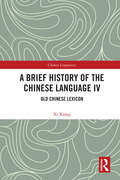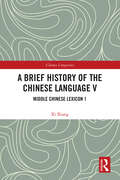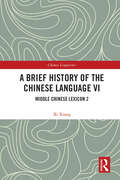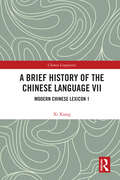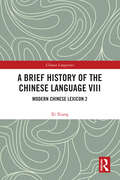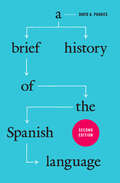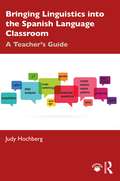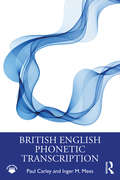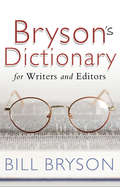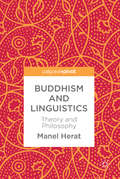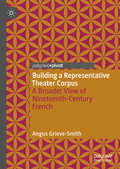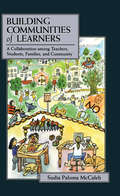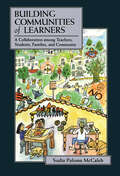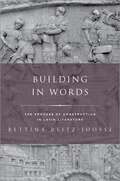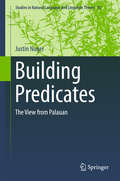- Table View
- List View
A Brief History of the Chinese Language IV: Old Chinese Lexicon (Chinese Linguistics)
by Xi XiangAs the fourth volume of a multi-volume set on the Chinese language, this book studies the lexical system of Old Chinese and the development of different types of lexicons during the period. Focusing on lexicons in Old Chinese, the early form of the Chinese language used between the 18th century BCE and the 3rd century CE, this volume first introduces the methods of word formation in Old Chinese by analyzing words inscribed in oracle bones of the Shang Dynasty. Illustrated with examples, it then examines the lexical features of Old Chinese and explores the progress and evolutionary features of monosyllabic words, polysyllabic words, lexical meanings, synonyms, and idioms and proverbs over the course of the volume.This comprehensive groundwork on Chinese lexical history is a must-read for scholars and students studying ancient Chinese language, linguistics, and especially for beginning learners of the Old Chinese lexicon.
A Brief History of the Chinese Language IV: Old Chinese Lexicon (Chinese Linguistics)
by Xi XiangAs the fourth volume of a multi-volume set on the Chinese language, this book studies the lexical system of Old Chinese and the development of different types of lexicons during the period. Focusing on lexicons in Old Chinese, the early form of the Chinese language used between the 18th century BCE and the 3rd century CE, this volume first introduces the methods of word formation in Old Chinese by analyzing words inscribed in oracle bones of the Shang Dynasty. Illustrated with examples, it then examines the lexical features of Old Chinese and explores the progress and evolutionary features of monosyllabic words, polysyllabic words, lexical meanings, synonyms, and idioms and proverbs over the course of the volume.This comprehensive groundwork on Chinese lexical history is a must-read for scholars and students studying ancient Chinese language, linguistics, and especially for beginning learners of the Old Chinese lexicon.
A Brief History of the Chinese Language V: Middle Chinese Lexicon 1 (Chinese Linguistics)
by Xi XiangAs the fifth volume of a multi-volume set on the Chinese language, this book studies the development of monosyllables and polysyllables in Middle Chinese and the overall evolution of lexical meanings during the period.Focusing on lexicons in Middle Chinese, the Chinese language used between the 4th century AD and the 12th century AD, the book first introduces the monosyllabic neologisms of Middle Chinese, including characters and words derived from Old Chinese lexicons and those newly created. It then examines the development of polysyllabic words in Middle Chinese, ranging from single morpheme words, tautologies and compound words. The final chapter discusses the changes and extension of word meanings in medieval Chinese.Illustrated with abundant examples, this comprehensive groundwork on Chinese lexical history will be a must read for scholars and students studying ancient Chinese language, linguistics and especially for beginning learners of the Middle Chinese lexicon.
A Brief History of the Chinese Language V: Middle Chinese Lexicon 1 (Chinese Linguistics)
by Xi XiangAs the fifth volume of a multi-volume set on the Chinese language, this book studies the development of monosyllables and polysyllables in Middle Chinese and the overall evolution of lexical meanings during the period.Focusing on lexicons in Middle Chinese, the Chinese language used between the 4th century AD and the 12th century AD, the book first introduces the monosyllabic neologisms of Middle Chinese, including characters and words derived from Old Chinese lexicons and those newly created. It then examines the development of polysyllabic words in Middle Chinese, ranging from single morpheme words, tautologies and compound words. The final chapter discusses the changes and extension of word meanings in medieval Chinese.Illustrated with abundant examples, this comprehensive groundwork on Chinese lexical history will be a must read for scholars and students studying ancient Chinese language, linguistics and especially for beginning learners of the Middle Chinese lexicon.
A Brief History of the Chinese Language VI: Middle Chinese Lexicon 2 (Chinese Linguistics)
by Xi XiangAs the sixth volume of a multi-volume set on the Chinese language, this book studies the influence of foreign culture on Middle Chinese lexicon and the development of synonyms, idioms and proverbs during the period.Focusing on lexicons in Middle Chinese, the middle form of the Chinese language used between the 4th century AD and the 12th century AD, this book first analyzes loanwords in Middle Chinese, a product of cultural exchange with western regions on the silk road and the impact of Buddhism. It then discusses the differences in meaning between monosyllables and polysyllables. The final chapter describes enriching idioms and proverbs and the major sources of words, including classical works, Buddhist texts and the spoken language.Illustrated with abundant examples, this comprehensive groundwork on Chinese lexical history will be a must read for scholars and students studying ancient Chinese language, linguistics and especially for beginning learners of the Middle Chinese lexicon.
A Brief History of the Chinese Language VI: Middle Chinese Lexicon 2 (Chinese Linguistics)
by Xi XiangAs the sixth volume of a multi-volume set on the Chinese language, this book studies the influence of foreign culture on Middle Chinese lexicon and the development of synonyms, idioms and proverbs during the period.Focusing on lexicons in Middle Chinese, the middle form of the Chinese language used between the 4th century AD and the 12th century AD, this book first analyzes loanwords in Middle Chinese, a product of cultural exchange with western regions on the silk road and the impact of Buddhism. It then discusses the differences in meaning between monosyllables and polysyllables. The final chapter describes enriching idioms and proverbs and the major sources of words, including classical works, Buddhist texts and the spoken language.Illustrated with abundant examples, this comprehensive groundwork on Chinese lexical history will be a must read for scholars and students studying ancient Chinese language, linguistics and especially for beginning learners of the Middle Chinese lexicon.
A Brief History of the Chinese Language VII: Modern Chinese Lexicon 1 (Chinese Linguistics)
by Xi XiangAs the seventh volume of a multi-volume set on the Chinese language, this book studies the Mongolian influence on neologisms in Modern Chinese and innovations in word formation and lexical meanings during the period.Focusing on lexicons in Modern Chinese, the Chinese language used since the 13th century CE, this book first introduces new monosyllables and the entry of spoken idioms and dialects into the written language as well as the mingling of the Chinese language with the Mongolian and Manchu languages. It then focuses on the development and features of polysyllabic words in Modern Chinese, covering alliterative and rhyming compounds and trisyllabic and four-syllable words. The final chapter discusses the change of lexical meaning systems in Modern Chinese based on an analysis of monosyllables, disyllables and polysyllables.Illustrated with abundant examples, this comprehensive groundwork on Chinese lexical history will be a must read for scholars and students studying the modern Chinese language and linguistics and especially for beginning learners of the modern Chinese lexicon.
A Brief History of the Chinese Language VIII: Modern Chinese Lexicon 2 (Chinese Linguistics)
by Xi XiangAs the final volume of a multi-volume set on the Chinese language, this book studies the Western and Japanese influence on the lexicon of Modern Chinese, lexical developments in synonyms, idioms and proverbs in modern times, and lexical developments in contemporary times.This volume first introduces the influence of foreign cultures on the modern Chinese lexicon with an emphasis on loanwords from Japanese and Indo-European languages. It then discusses the synonyms, idioms and proverbs of Modern Chinese, elucidating their evolution, sources and composition. The final part centers on the development of the Chinese lexicon after the May 4 Movement in 1919, marking the beginning of the contemporary phase of the Chinese language. The author analyses trends and types of neologisms and loanwords and analyzes the blend of Mandarin and dialect words as well as the necessity of lexical standardization.Illustrated with abundant examples, this comprehensive groundwork on Chinese lexical history will be a must read for scholars and students studying modern Chinese language, linguistics and especially for beginning learners of modern and contemporary Chinese lexicon.
A Brief History of the Chinese Language VIII: Modern Chinese Lexicon 2 (Chinese Linguistics)
by Xi XiangAs the final volume of a multi-volume set on the Chinese language, this book studies the Western and Japanese influence on the lexicon of Modern Chinese, lexical developments in synonyms, idioms and proverbs in modern times, and lexical developments in contemporary times.This volume first introduces the influence of foreign cultures on the modern Chinese lexicon with an emphasis on loanwords from Japanese and Indo-European languages. It then discusses the synonyms, idioms and proverbs of Modern Chinese, elucidating their evolution, sources and composition. The final part centers on the development of the Chinese lexicon after the May 4 Movement in 1919, marking the beginning of the contemporary phase of the Chinese language. The author analyses trends and types of neologisms and loanwords and analyzes the blend of Mandarin and dialect words as well as the necessity of lexical standardization.Illustrated with abundant examples, this comprehensive groundwork on Chinese lexical history will be a must read for scholars and students studying modern Chinese language, linguistics and especially for beginning learners of modern and contemporary Chinese lexicon.
A Brief History of the Spanish Language: Second Edition
by David A. PhariesSince its publication in 2007, A Brief History of the Spanish Language has become the leading introduction to the history of one of the world’s most widely spoken languages. Moving from the language’s Latin roots to its present-day forms, this concise book offers readers insights into the origin and evolution of Spanish, the historical and cultural changes that shaped it, and its spread around the world. A Brief History of the Spanish Language focuses on the most important aspects of the development of the Spanish language, eschewing technical jargon in favor of straightforward explanations. Along the way, it answers many of the common questions that puzzle native speakers and non-native speakers alike, such as: Why do some regions use tú while others use vos? How did the th sound develop in Castilian? And why is it la mesa but el agua? David A. Pharies, a world-renowned expert on the history and development of Spanish, has updated this edition with new research on all aspects of the evolution of Spanish and current demographic information. This book is perfect for anyone with a basic understanding of Spanish and a desire to further explore its roots. It also provides an ideal foundation for further study in any area of historical Spanish linguistics and early Spanish literature. A Brief History of the Spanish Language is a grand journey of discovery, revealing in a beautifully compact format the fascinating story of the language in both Spain and Spanish America.
A Brief History of the Spanish Language: Second Edition
by David A. PhariesSince its publication in 2007, A Brief History of the Spanish Language has become the leading introduction to the history of one of the world’s most widely spoken languages. Moving from the language’s Latin roots to its present-day forms, this concise book offers readers insights into the origin and evolution of Spanish, the historical and cultural changes that shaped it, and its spread around the world. A Brief History of the Spanish Language focuses on the most important aspects of the development of the Spanish language, eschewing technical jargon in favor of straightforward explanations. Along the way, it answers many of the common questions that puzzle native speakers and non-native speakers alike, such as: Why do some regions use tú while others use vos? How did the th sound develop in Castilian? And why is it la mesa but el agua? David A. Pharies, a world-renowned expert on the history and development of Spanish, has updated this edition with new research on all aspects of the evolution of Spanish and current demographic information. This book is perfect for anyone with a basic understanding of Spanish and a desire to further explore its roots. It also provides an ideal foundation for further study in any area of historical Spanish linguistics and early Spanish literature. A Brief History of the Spanish Language is a grand journey of discovery, revealing in a beautifully compact format the fascinating story of the language in both Spain and Spanish America.
A Brief History of the Spanish Language: Second Edition
by David A. PhariesSince its publication in 2007, A Brief History of the Spanish Language has become the leading introduction to the history of one of the world’s most widely spoken languages. Moving from the language’s Latin roots to its present-day forms, this concise book offers readers insights into the origin and evolution of Spanish, the historical and cultural changes that shaped it, and its spread around the world. A Brief History of the Spanish Language focuses on the most important aspects of the development of the Spanish language, eschewing technical jargon in favor of straightforward explanations. Along the way, it answers many of the common questions that puzzle native speakers and non-native speakers alike, such as: Why do some regions use tú while others use vos? How did the th sound develop in Castilian? And why is it la mesa but el agua? David A. Pharies, a world-renowned expert on the history and development of Spanish, has updated this edition with new research on all aspects of the evolution of Spanish and current demographic information. This book is perfect for anyone with a basic understanding of Spanish and a desire to further explore its roots. It also provides an ideal foundation for further study in any area of historical Spanish linguistics and early Spanish literature. A Brief History of the Spanish Language is a grand journey of discovery, revealing in a beautifully compact format the fascinating story of the language in both Spain and Spanish America.
A Brief History of the Spanish Language: Second Edition
by David A. PhariesSince its publication in 2007, A Brief History of the Spanish Language has become the leading introduction to the history of one of the world’s most widely spoken languages. Moving from the language’s Latin roots to its present-day forms, this concise book offers readers insights into the origin and evolution of Spanish, the historical and cultural changes that shaped it, and its spread around the world. A Brief History of the Spanish Language focuses on the most important aspects of the development of the Spanish language, eschewing technical jargon in favor of straightforward explanations. Along the way, it answers many of the common questions that puzzle native speakers and non-native speakers alike, such as: Why do some regions use tú while others use vos? How did the th sound develop in Castilian? And why is it la mesa but el agua? David A. Pharies, a world-renowned expert on the history and development of Spanish, has updated this edition with new research on all aspects of the evolution of Spanish and current demographic information. This book is perfect for anyone with a basic understanding of Spanish and a desire to further explore its roots. It also provides an ideal foundation for further study in any area of historical Spanish linguistics and early Spanish literature. A Brief History of the Spanish Language is a grand journey of discovery, revealing in a beautifully compact format the fascinating story of the language in both Spain and Spanish America.
Bringing Linguistics into the Spanish Language Classroom: A Teacher's Guide
by Judy HochbergBringing Linguistics into the Spanish Language Classroom is a practical, time-saving resource that allows teachers to easily integrate the most interesting and important findings of Hispanic linguistics into their Spanish language classes. Teachers will find classroom-ready explanations and PowerPoint slides for each topic covered, as well as instructions and materials for in-class activities and take-home projects that will engage students in this fresh take on the target language. Slide presentations for each chapter are available online at www.routledge.com/9780367111960. The book covers aspects of Spanish from the trilled r to the personal a, from Indo-European origins to modern dialects, and from children’s first words to adult speech errors. An innovative set of five linguistics-based essential questions organizes and contextualizes this wide range of material: How is Spanish different from other languages? How is Spanish similar to other languages? What are the roots of Spanish? How does Spanish vary? How do people learn and use Spanish? Fully customizable to teacher and student interest, proficiency level, and time available in class, this book is ideal for Spanish language teachers looking to incorporate valuable linguistic insights into their curricula, even if they lack prior knowledge of this field. It is an excellent resource for Hispanic linguistics courses as well.
Bringing Linguistics into the Spanish Language Classroom: A Teacher's Guide
by Judy HochbergBringing Linguistics into the Spanish Language Classroom is a practical, time-saving resource that allows teachers to easily integrate the most interesting and important findings of Hispanic linguistics into their Spanish language classes. Teachers will find classroom-ready explanations and PowerPoint slides for each topic covered, as well as instructions and materials for in-class activities and take-home projects that will engage students in this fresh take on the target language. Slide presentations for each chapter are available online at www.routledge.com/9780367111960. The book covers aspects of Spanish from the trilled r to the personal a, from Indo-European origins to modern dialects, and from children’s first words to adult speech errors. An innovative set of five linguistics-based essential questions organizes and contextualizes this wide range of material: How is Spanish different from other languages? How is Spanish similar to other languages? What are the roots of Spanish? How does Spanish vary? How do people learn and use Spanish? Fully customizable to teacher and student interest, proficiency level, and time available in class, this book is ideal for Spanish language teachers looking to incorporate valuable linguistic insights into their curricula, even if they lack prior knowledge of this field. It is an excellent resource for Hispanic linguistics courses as well.
British English Phonetic Transcription
by Paul Carley Inger M. MeesBritish English Phonetic Transcription provides an accessible introduction to phonemic, phonetic and intonational transcription with a focus on British English. Featuring exercises, revision tasks and recordings to help students gain hands-on practice, the book takes a learning-by-doing approach and ensures students gain practice using each new symbol or concept introduced before moving on to the next. Consisting of three parts, the book covers: transcribing individual words, including consonants, vowels, primary stress, secondary stress, syllabic consonants and inflections; transcribing phrases and sentences, including liaison, weak forms, elision and assimilation; transcribing intonation, including the structure of English intonation and recognising pitch patterns. Ideally suited as a standalone workbook or for use alongside American English Phonetic Transcription, British English Phonetic Transcription is key reading for undergraduate students of linguistics as well as anyone teaching or learning English as a foreign language.
British English Phonetic Transcription
by Paul Carley Inger M. MeesBritish English Phonetic Transcription provides an accessible introduction to phonemic, phonetic and intonational transcription with a focus on British English. Featuring exercises, revision tasks and recordings to help students gain hands-on practice, the book takes a learning-by-doing approach and ensures students gain practice using each new symbol or concept introduced before moving on to the next. Consisting of three parts, the book covers: transcribing individual words, including consonants, vowels, primary stress, secondary stress, syllabic consonants and inflections; transcribing phrases and sentences, including liaison, weak forms, elision and assimilation; transcribing intonation, including the structure of English intonation and recognising pitch patterns. Ideally suited as a standalone workbook or for use alongside American English Phonetic Transcription, British English Phonetic Transcription is key reading for undergraduate students of linguistics as well as anyone teaching or learning English as a foreign language.
Bryson's Dictionary: for Writers and Editors
by Bill BrysonWhat is the difference between cant and jargon, or assume and presume? What is a fandango? How do you spell supersede? Is it hippy or hippie? These questions really matter to Bill Bryson, as they do to anyone who cares about the English language. Originally published as The Penguin Dictionary for Writers and Editors, Bryson's Dictionary for Writers and Editors has now been completely revised and updated for the twenty-first century by Bill Bryson himself. Here is a very personal selection of spellings and usages, covering such head-scratchers as capitalization, plurals, abbreviations and foreign names and phrases. Bryson also gives us the difference between British and American usages, and miscellaneous pieces of essential information you never knew you needed, like the names of all the Oxford colleges, or the correct spelling of Brobdingnag. An indispensable companion to all those who write, work with the written word, or who just enjoy getting things right, it gives rulings that are both authoritative and commonsense, all in Bryson's own inimitably goodhumoured way.
Buddhism and Linguistics: Theory and Philosophy (PDF)
by Manel HeratThis edited collection brings linguistics into contact with a millennia of works by Buddhist scholars. Examining the Buddhist contemplative tradition and its extensive writings from an interdisciplinary perspective, the authors bridge the gap between such customs and human language. To do so, they provide chapters on linguistics, history, religious studies, philosophy and semiotics. Uniting scholars from three different continents and from many disciplines and institutions, this innovative and unique book is sure to appeal to anyone interested in Buddhist traditions and linguistics.
Building a Representative Theater Corpus: A Broader View of Nineteenth-Century French
by Angus Grieve-SmithThe Digital Parisian Stage Project aims to compile a corpus of plays that are representative of performances in the theaters of Paris through history. This book surveys existing corpora that cover the nineteenth century, lays out the issue of corpus representativeness in detail, and, using a random sample of plays from this period, presents two case studies of language in use in the Napoleonic era. It presents a compelling argument for the compilation and use of representative corpora in linguistic study, and will be of interest to those working in the fields of corpus linguistics, digital humanities, and history of the theater.
Building Communities of Learners: A Collaboration Among Teachers, Students, Families, and Community
by Sudia Paloma McCalebThis popular text shows how teachers can create partnerships with parents and students that facilitate participation in the schools while also validating home culture and family concerns and aspirations. It reflects current research and theory in several areas related to literacy development, including family literacy, bilingual and multicultural education, critical pedagogy, participatory research, cooperative learning, and feminist perspectives. Teachers of students who are immigrants, non-native speakers of English, and members of marginalized groups will find this book especially pertinent.
Building Communities of Learners: A Collaboration Among Teachers, Students, Families, and Community
by Sudia Paloma McCalebThis popular text shows how teachers can create partnerships with parents and students that facilitate participation in the schools while also validating home culture and family concerns and aspirations. It reflects current research and theory in several areas related to literacy development, including family literacy, bilingual and multicultural education, critical pedagogy, participatory research, cooperative learning, and feminist perspectives. Teachers of students who are immigrants, non-native speakers of English, and members of marginalized groups will find this book especially pertinent.
Building in Words: Representations of the Process of Construction in Latin Literature (Classical Culture and Society)
by Bettina Reitz-JoosseBuilding in Words explores the relationship between text and architecture in the Roman world from the perspective of architectural process. Ancient Romans frequently encountered buildings under construction - they experienced noisy building work, disruptive transportation of materials, and sometimes spectacular engineering feats. Bettina Reitz-Joosse analyzes how Roman authors responded to the process of building and construction in their literary works. Roman authors tell stories of architectural creation to give meaning to finished monuments. Their narratives can stress technological or logistic mastery or highlight morally problematic aspects of construction, particularly in large-scale engineering projects. While offering descriptions of the process of creating architecture, Roman writers also reflect on the creation of their own works. Building in Words demonstrates the richness of the image of construction for literary composition: writers use it to comment on the aesthetics or ambition of their literary work, to articulate the power and durability, but also the fragility of literature. Reitz-Joosse here offers original readings of a range of literary authors of the early Roman empire, including Vergil, Pliny the Elder, Tacitus, and Statius, and places literary texts in dialogue with contemporary epigraphic and archaeological material. Through its focus on building as a process, Building in Words furthers our understanding of the aesthetics of both architecture and literature in ancient Rome.
Building in Words: Representations of the Process of Construction in Latin Literature (Classical Culture and Society)
by Bettina Reitz-JoosseBuilding in Words explores the relationship between text and architecture in the Roman world from the perspective of architectural process. Ancient Romans frequently encountered buildings under construction - they experienced noisy building work, disruptive transportation of materials, and sometimes spectacular engineering feats. Bettina Reitz-Joosse analyzes how Roman authors responded to the process of building and construction in their literary works. Roman authors tell stories of architectural creation to give meaning to finished monuments. Their narratives can stress technological or logistic mastery or highlight morally problematic aspects of construction, particularly in large-scale engineering projects. While offering descriptions of the process of creating architecture, Roman writers also reflect on the creation of their own works. Building in Words demonstrates the richness of the image of construction for literary composition: writers use it to comment on the aesthetics or ambition of their literary work, to articulate the power and durability, but also the fragility of literature. Reitz-Joosse here offers original readings of a range of literary authors of the early Roman empire, including Vergil, Pliny the Elder, Tacitus, and Statius, and places literary texts in dialogue with contemporary epigraphic and archaeological material. Through its focus on building as a process, Building in Words furthers our understanding of the aesthetics of both architecture and literature in ancient Rome.
Building Predicates: The View from Palauan (Studies in Natural Language and Linguistic Theory #92)
by Justin NugerThis volume provides a comprehensive analysis of the syntax of Palauan that will appeal to anyone interested in Austronesian languages or formal syntactic and morphological theory. This volume proposes that words in Palauan are not drawn directly from a mental lexicon, but are instead composed at least partially in the syntax. Using original data from syntactic constructions not previously explored in the language, the author entertains several competing theories of word formation and highlights the compatible and incompatible aspects of each, through an exploration into new corners of Palauan syntax and morphology.
